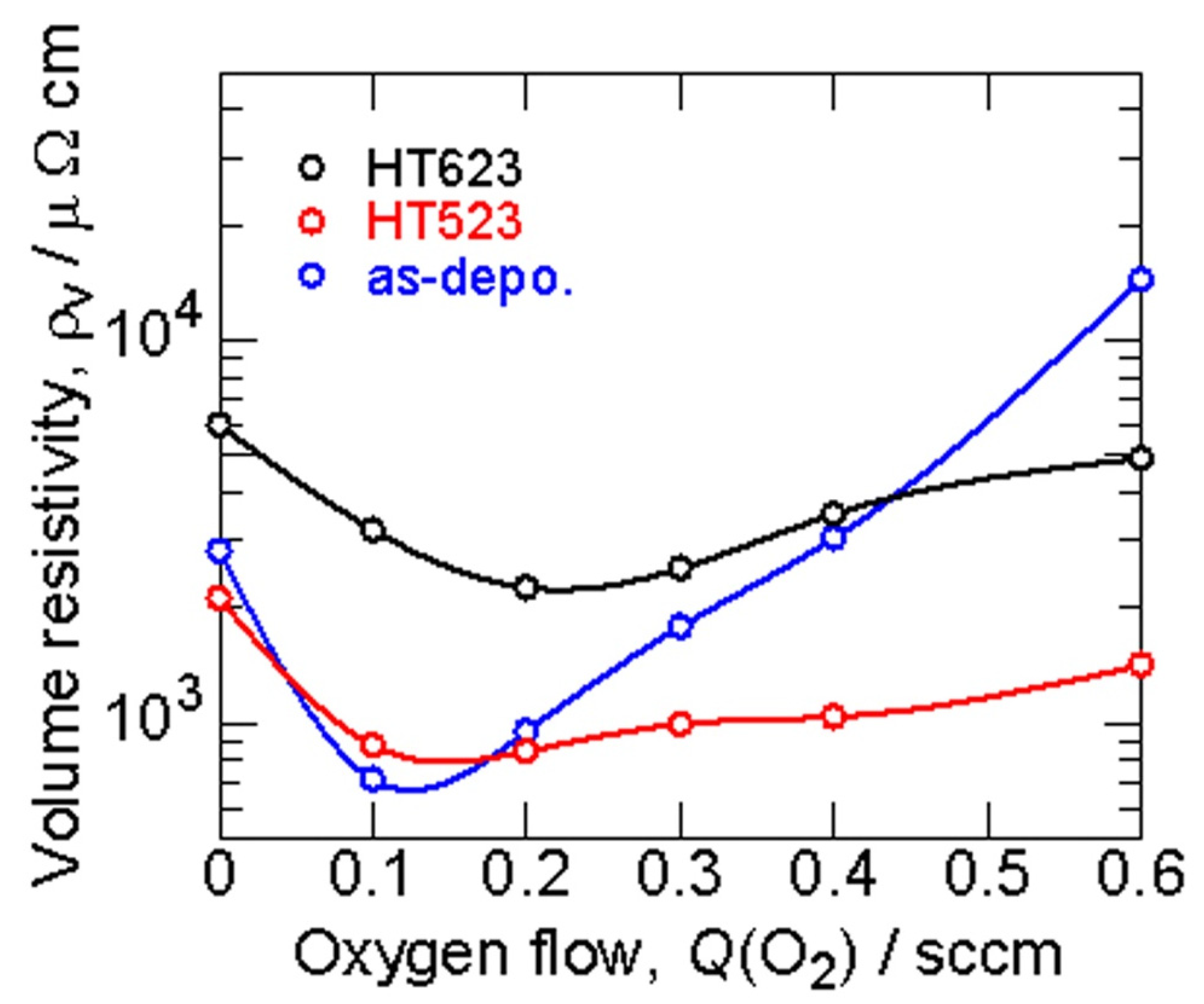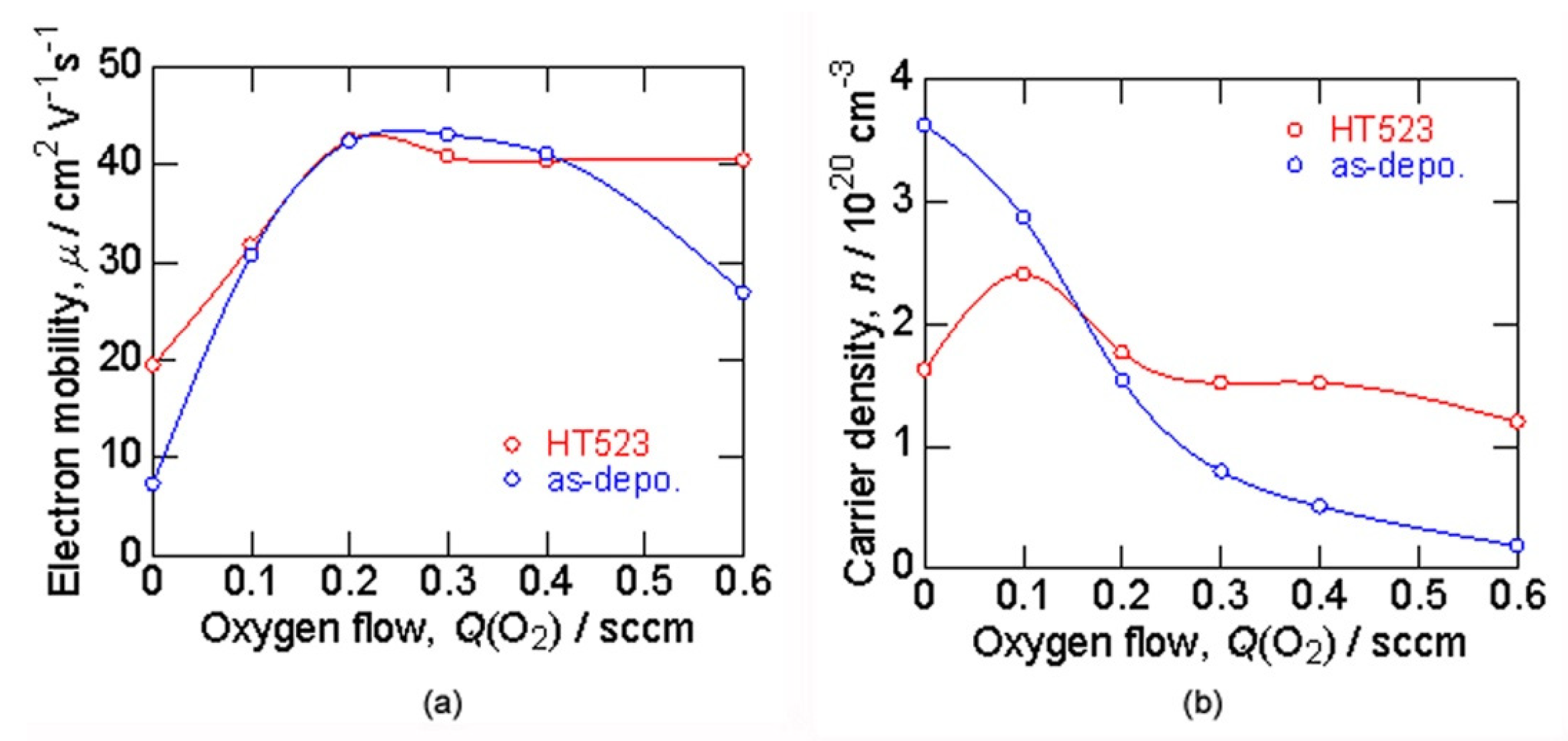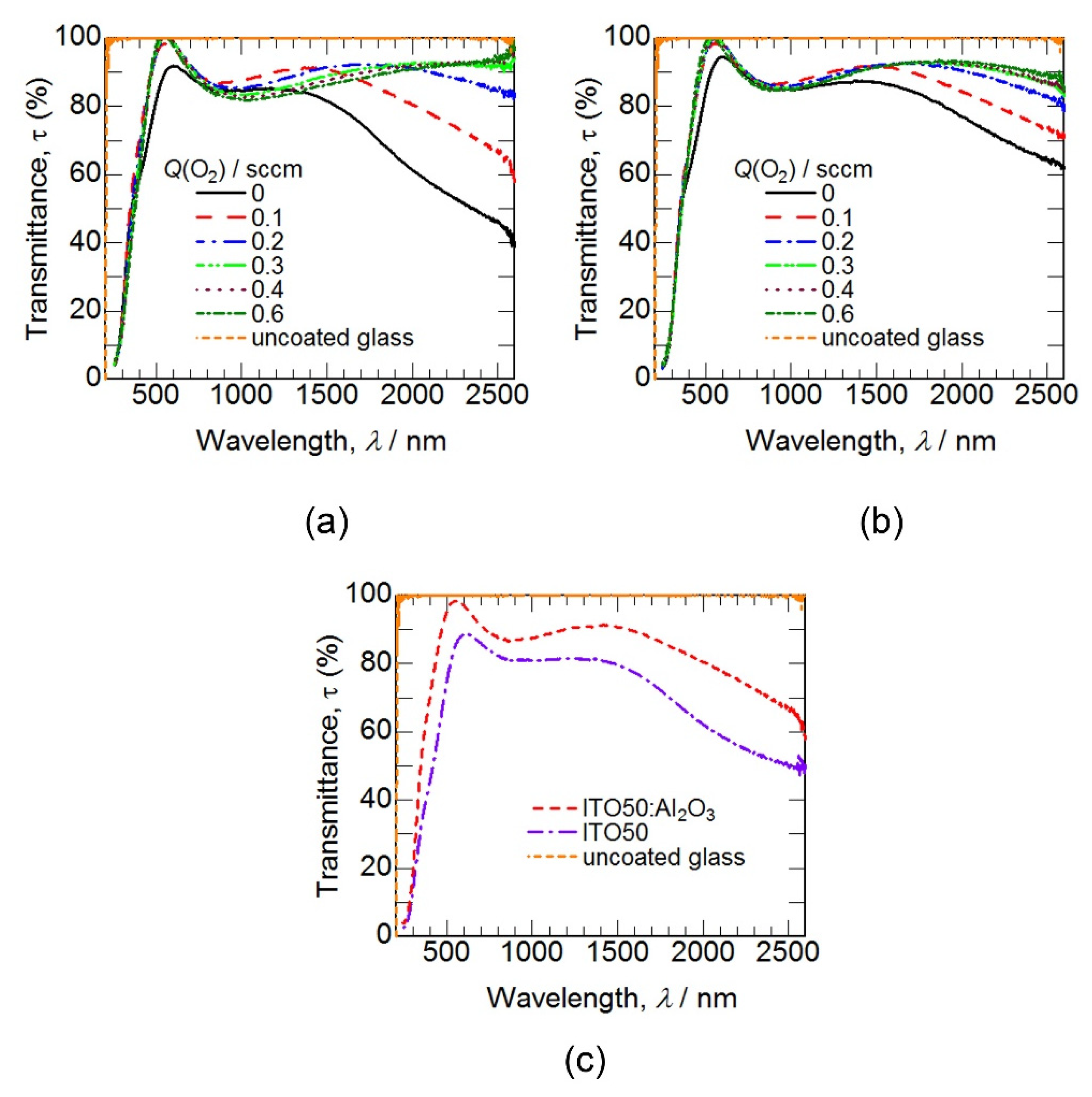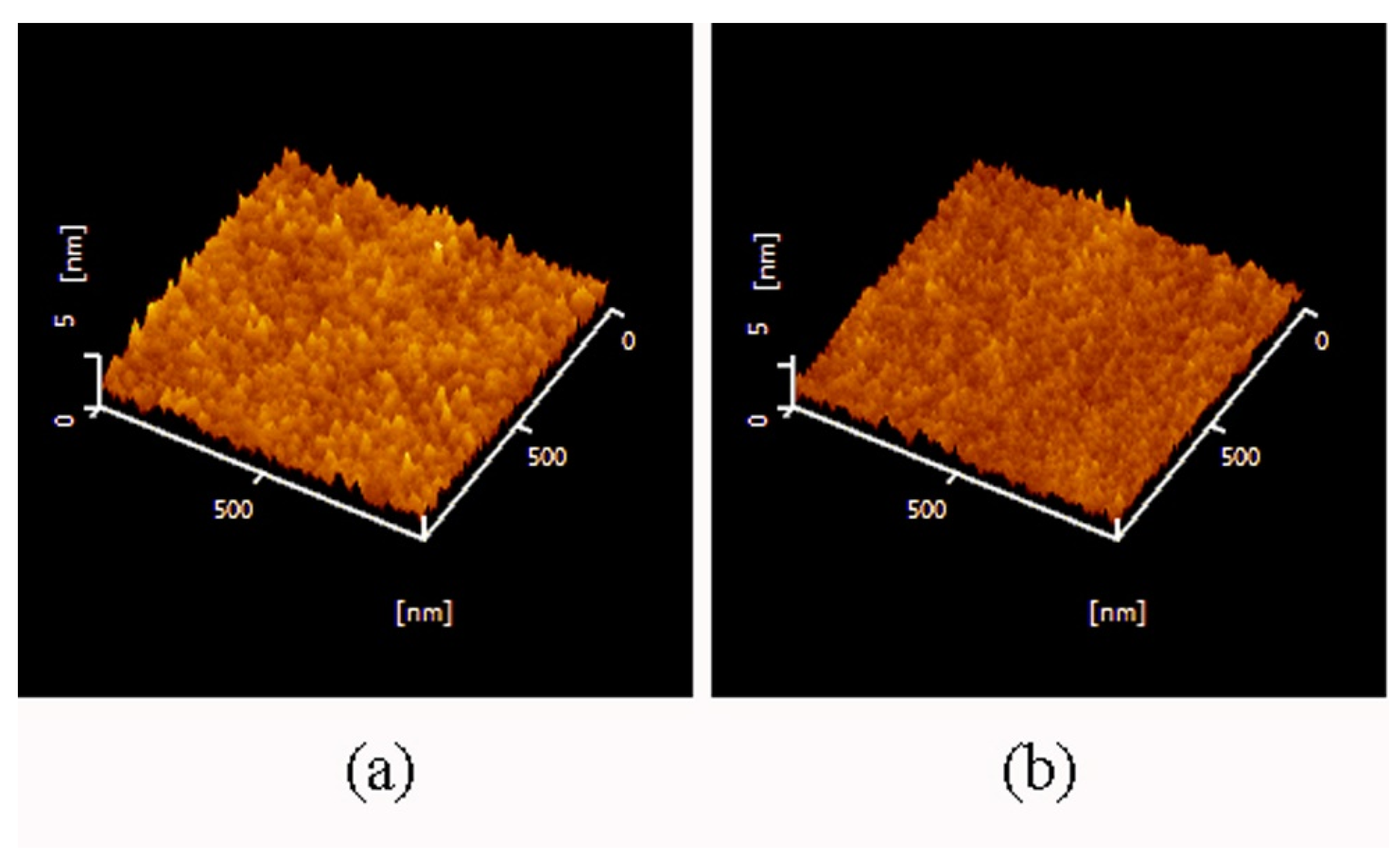Effect of Oxygen Flow Rate on Properties of Aluminum-Doped Indium-Saving Indium Tin Oxide (ITO) Thin Films Sputtered on Preheated Glass Substrates
Abstract
:1. Introduction
2. Materials and Methods
3. Results
3.1. Deposition Rate
3.2. Optical and Electrical Properties
3.3. Structural Properties
4. Conclusions
Author Contributions
Funding
Institutional Review Board Statement
Informed Consent Statement
Data Availability Statement
Acknowledgments
Conflicts of Interest
References
- Siddiqui, M.S.; Saxena, A.K.; Singh, S.P. Deposition and characterization of ITO thin film over glass for defogger application and for solar photovoltaics. Int. J. Curr. Eng. Technol. 2018, 8, 900–903. [Google Scholar] [CrossRef]
- Gwamuri, J.; Vora, A.; Mayandi, J.; Güney, D.Ö.; Bergstrom, P.L.; Pearce, J.M. A new method of preparing highly conductive ultra-thin indium tin oxide for plasmonic-enhanced thin film solar photovoltaic devices. Sol. Energy Mater Sol. Cells 2016, 149, 250–257. [Google Scholar] [CrossRef] [Green Version]
- Betz, U.; Olsson, M.K.; Marthy, J.; Escolá, M.F.; Atamny, F. Thin films engineering of indium tin oxide: Large area flat panel displays application. Surf. Coat. Tech. 2006, 200, 5751–5759. [Google Scholar] [CrossRef]
- Sibin, K.P.; Swain, N.; Chowdhury, P.; Dey, A.; Sridhara, N.; Shashikala, H.D.; Sharma, A.K.; Barshilia, H.C. Optical and electrical properties of ITO thin films sputtered on flexible FEP substrate as passive thermal control system for space applications. Sol. Energy Mater. Sol. Cells 2016, 145, 314–322. [Google Scholar] [CrossRef]
- Latz, R.; Michael, K.; Scherer, M. High Conducting Large Area Indium Tin Oxide Electrodes for Displays Prepared by DC Magnetron Sputtering. Jpn. J. Appl. Phys. 1991, 30, L149–L151. [Google Scholar] [CrossRef]
- Minami, T.; Takeda, Y.; Takata, S.; Kakumu, T. Preparation of transparent conducting In4Sn3O12 thin films by DC magnetron sputtering. Thin Solid Films 1997, 308–309, 13–18. [Google Scholar] [CrossRef]
- O’Neil, D.H.; Kuznetsov, V.L.; Jacobs, R.M.J.; Jones, M.O.; Edwards, P.P. Structural, optical and electrical properties of In4Sn3O12 films prepared by pulsed laser deposition. Mater. Chem. Phys. 2010, 123, 152–159. [Google Scholar] [CrossRef]
- Thirumoorthi, M.; Prakash, J.T.J. Structure, optical and electrical properties of indium tin oxide ultrathin films prepared by jet nebulizer spray pyrolysis technique. J. Asian Ceram. Soc. 2016, 4, 124–132. [Google Scholar] [CrossRef] [Green Version]
- Epifani, M.; Diaz, R.; Arbiol, J.; Siciliano, P.; Morante, J.R. Solution Synthesis of Thin Films in the SnO2-In2O3 System: A Case Study of the Mixing of Sol-Gel and Metal-Organic Solution Processes. Chem. Mater. 2006, 18, 840–846. [Google Scholar] [CrossRef]
- Li, S.; Qiao, X.; Chen, J. Effects of oxygen flow on the properties of indium tin oxide films. Mater. Chem. Phys. 2006, 98, 144–147. [Google Scholar] [CrossRef]
- Cindemir, U.; Lansåker, P.C.; Österlund, L.; Niklasson, G.A.; Granqvist, C.-G. Sputter-Deposited Indium–Tin Oxide Thin Films for Acetaldehyde Gas Sensing. Coatings 2016, 6, 19–29. [Google Scholar] [CrossRef] [Green Version]
- Voisin, L.; Ohtsuka, M.; Petrovska, S.; Sergiienko, R.; Nakamura, T. Structural, optical and electrical properties of DC sputtered indium saving indium-tin oxide (ITO) thin films. Optik 2018, 156, 728–737. [Google Scholar] [CrossRef]
- Voisin, L.; Ohtsuka, M.; Nakamura, T. Titanium Doped ITO Thin Films Produced by Sputtering Method. Mater. Trans. 2010, 51, 503–509. [Google Scholar] [CrossRef] [Green Version]
- Ohtsuka, M.; Sergiienko, R.; Petrovska, S.; Ilkiv, B.; Nakamura, T. Effect of Sputtering Power on Optoelectronic Properties of Iron-Doped Indium Saving Indium-tin oxide (ITO) Thin Films. Metallofiz. Noveishie Technol. 2019, 41, 941–952. [Google Scholar] [CrossRef] [Green Version]
- Ohtsuka, M.; Sergiienko, R.; Petrovska, S.; Ilkiv, B.; Nakamura, T. Iron-doped indium saving indium-tin oxide (ITO) thin films sputtered on preheated substrates. Optik 2019, 179, 19–28. [Google Scholar] [CrossRef]
- Testing method for resistivity of conductive plastics with a four-point probe array. In Japanese Industrial Standards JIS K 7194-1994; Japanese Standards Association: Tokyo, Japan, 1994.
- Kerkache, L.; Layadi, A.; Mosser, A. Effect of oxygen partial pressure on the structural and optical properties of dc sputtered ITO thin films. J. Alloys Compd. 2009, 485, 46–50. [Google Scholar] [CrossRef]
- Mohamed, H.A. The effect of annealing and ZnO dopant on the optoelectronic properties of ITO thin films. J. Phys. D Appl. Phys. 2007, 40, 4234–4240. [Google Scholar] [CrossRef]
- Heward, W.J.; Swenson, D.J. Phase equilibria in the pseudo-binary In2O3–SnO2 system. J. Mater. Sci. 2007, 42, 7135–7140. [Google Scholar] [CrossRef]
- Nadaud, N.; Nanot, M.; Jove, J.; Roisnel, T. A Structural Study of Tin-Doped Indium Oxide (ITO) Ceramics Using 119Sn Mössbauer Spectroscopy and Neutron Diffraction. Key Eng. Mater. 1997, 132, 1373–1376. [Google Scholar] [CrossRef]





| Deposition Parameters | Oxygen Flow Rate, sccm | Average Value ± std. dev. | |||||
|---|---|---|---|---|---|---|---|
| 0 | 0.1 | 0.2 | 0.3 | 0.4 | 0.6 | ||
| Film thickness (d), nm | 131.6 | 127.1 | 126.4 | 127.4 | 128.1 | 123.5 | 127.25 ± 0.70 |
| Deposition rate (rdep), nm/min | 4.39 | 4.24 | 4.21 | 4.25 | 4.27 | 4.12 | 4.24 ± 0.02 |
| Sample | Oxygen Flow, sccm | Sa, nm | Sq, nm |
|---|---|---|---|
| depo. SL ITO50:Al2O3 | 0.2 | 0.44 | 0.55 |
| SL ITO50:Al2O3 HT923 | 0.2 | 0.42 | 0.53 |
| SL ITO50 [12] | 0.5 | 0.49 | 0.61 |
| SL ITO90 [12] | 0.2 | 12.8 | 15.7 |
Publisher’s Note: MDPI stays neutral with regard to jurisdictional claims in published maps and institutional affiliations. |
© 2021 by the authors. Licensee MDPI, Basel, Switzerland. This article is an open access article distributed under the terms and conditions of the Creative Commons Attribution (CC BY) license (https://creativecommons.org/licenses/by/4.0/).
Share and Cite
Petrovska, S.; Sergiienko, R.; Ilkiv, B.; Nakamura, T.; Ohtsuka, M. Effect of Oxygen Flow Rate on Properties of Aluminum-Doped Indium-Saving Indium Tin Oxide (ITO) Thin Films Sputtered on Preheated Glass Substrates. Metals 2021, 11, 1604. https://doi.org/10.3390/met11101604
Petrovska S, Sergiienko R, Ilkiv B, Nakamura T, Ohtsuka M. Effect of Oxygen Flow Rate on Properties of Aluminum-Doped Indium-Saving Indium Tin Oxide (ITO) Thin Films Sputtered on Preheated Glass Substrates. Metals. 2021; 11(10):1604. https://doi.org/10.3390/met11101604
Chicago/Turabian StylePetrovska, Svitlana, Ruslan Sergiienko, Bogdan Ilkiv, Takashi Nakamura, and Makoto Ohtsuka. 2021. "Effect of Oxygen Flow Rate on Properties of Aluminum-Doped Indium-Saving Indium Tin Oxide (ITO) Thin Films Sputtered on Preheated Glass Substrates" Metals 11, no. 10: 1604. https://doi.org/10.3390/met11101604
APA StylePetrovska, S., Sergiienko, R., Ilkiv, B., Nakamura, T., & Ohtsuka, M. (2021). Effect of Oxygen Flow Rate on Properties of Aluminum-Doped Indium-Saving Indium Tin Oxide (ITO) Thin Films Sputtered on Preheated Glass Substrates. Metals, 11(10), 1604. https://doi.org/10.3390/met11101604






